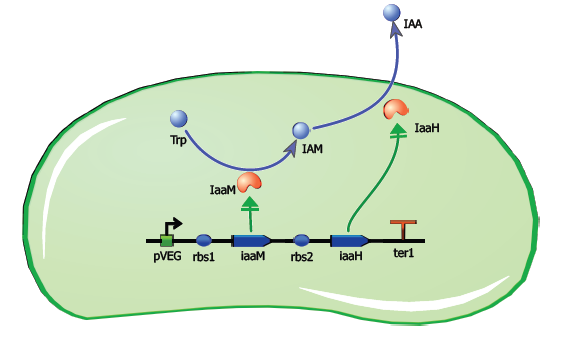Team:Imperial College London/Project/Auxin/Overview
From 2011.igem.org
RebekkaBauer (Talk | contribs) |
|||
| Line 1: | Line 1: | ||
| + | {{:Team:Imperial_College_London/Templates/Banner}} | ||
| + | {{:Team:Imperial_College_London/Templates/Menu}} | ||
<html> | <html> | ||
Indole-3 acetic acid (IAA) is one of the most well studied phytohormones and is also known more commonly under the name Auxin. IAA is known as a key player in the regulation of plant growth and is also a known morphogen implicated in a vast array of processes ranging from embryo patterning to isodiametric expansion (fruit growth).<br> | Indole-3 acetic acid (IAA) is one of the most well studied phytohormones and is also known more commonly under the name Auxin. IAA is known as a key player in the regulation of plant growth and is also a known morphogen implicated in a vast array of processes ranging from embryo patterning to isodiametric expansion (fruit growth).<br> | ||
Revision as of 10:36, 3 August 2011
However, the topic of auxin producing soil bacteria in the rhizosphere has been given little attention so far. We believe that plant-microbe interactions mediated through IAA could be tapped into to modulate the plasticity of the root architecture. In this module, we will be attempting to express Tryptophan monooxygenase (IaaM) and Idoleacetimide hydrolase (IaaH) in Escherichia coli. We are aware that E. coli would not be a suitable chassis for field work and we have taken this into account when we made our DNA sequences.
Design:
IaaM and IaaH have been codon optimized for both Bacillus subtilis and E. coli through the use of our own codon optimizing software. Also, the genes have been placed under the pVEG promoter which works in B. subtilis and E. coli and we calculated the RBS efficiency for both E. coli and B. subtilis. Furthermore, insulator sequences have been placed in front of the ribosome binding sites so that the genes could be placed under different promoters depending on desired output in different species.

The IAM pathway:
The IAM pathway taken for this module is from Pseudomonas savastanoi. This strain of soil dwelling bacteria is a known plant pathogen that uses IAA to infect its target. However, there have been some recent studies that suggest that IAA secretion by bacteria can also lead to positive microb-plant relations [1]. Therefore, we must carefully analyze what IAA concentration would aid root growth rather than promote gall formation. To achieve this, we will be experimenting with different levels of synthetic auxin on Arabidopsis thaliana. We will also be modelling this module in order to obtain the adequate concentration of IAA excretion from the chassis.
References:
[1] Stijn Spaepen, Jos Vanderleyden, and Roseline Remans, “Indole-3-acetic acid in microbial and microorganism-plant signaling,” FEMS Microbiology Reviews 31, no. 4 (July 2007): 425-448.
 "
"




